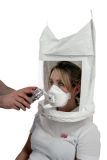Respirator fit testing is essential for worker safety
Wednesday, 08 August, 2012
Conducting a fit test to ensure that a respirator with a tight-fitting facepiece provides an adequate seal to the wearer’s face is deemed best practice as part of a respiratory protection program.
Reflecting this, a respiratory fit test is now mandated for compliance to AS/NZS1715:2009 (the standard for users of respiratory protection).

3M offers a complete range of disposable, re-usable and powered and supplied air respirators as well as 3M Qualitative Fit Test Kits to ensure initial good fit for disposable and re-usable respirators.
The 2009 edition of Australian Standard AS/NZS1715 released by Standards Australia supersedes the longstanding 1994 version. While the changes to the new version are not fundamental, it is important for employers and workers to understand the following changes and additions.
A complete respiratory protection program approach - stressing that all the elements of a program must be delivered to achieve the respiratory protection that is required. It has been the aim of the committee to stress that the provision of an item of respiratory protective equipment is only part of an overall system of respiratory protection for all employees.
Fit testing - it is clearly mandated that this is a necessary part of any program - Section 2.6 says, “The program administrator shall ensure a suitable fit test is carried out for all users of Respiratory Protective Equipment (RPE) with a close fitting facepiece.”
When to fit test
Fit testing should be carried out:
- Before the respirator is issued to all wearers of respirators with tight-fitting facepieces where fit testing has previously not been performed.
Fit testing should be repeated at appropriate times such as:
- If the wearer significantly loses or gains weight, has major dental work or sustains a major facial injury.
- If a different size or model of RPE is specified.
- At least annually or when specified by the company policy, eg, at time of health surveillance check.
Fit testing is in addition to the requirement to perform a fit check prior to each use as a gross determination of suitable fit.
This is an excerpt from 3M TechUpdate: Respirator Fit Testing, which can be found on the 3M website: 3m.com/au/ppesafety.
Smoke complexity, skin absorption and protective equipment in firefighter safety
To address health and safety questions raised by Australian firefighters, researchers have...
Will silicosis compensation costs rise despite Victoria's engineered stone ban?
Monash University researchers have explored whether silicosis compensation costs are set to...
Army aims to combat heat risk with wearable monitor prototype
A wearable heat risk monitor prototype for the Australian Defence Force is being trialled by Army...







